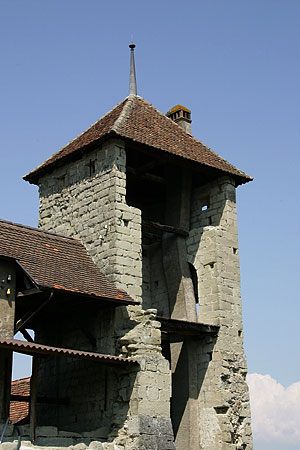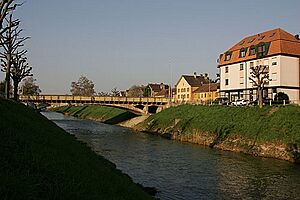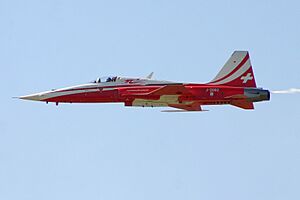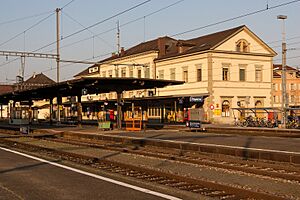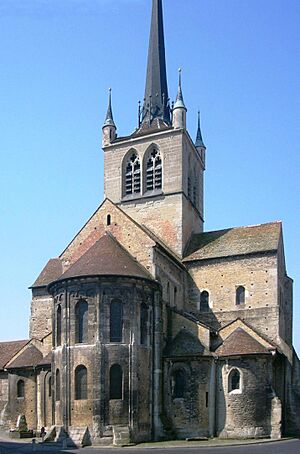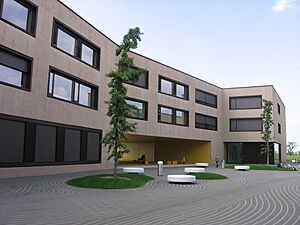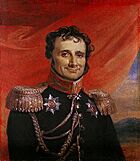Payerne facts for kids
Quick facts for kids
Payerne
|
||
|---|---|---|
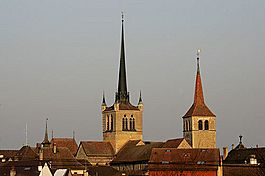
The towers of the Abbey and the Reformed church above Payerne
|
||
|
||
| Country | Switzerland | |
| Canton | Vaud | |
| District | Broye-Vully | |
| Area | ||
| • Total | 24.18 km2 (9.34 sq mi) | |
| Elevation | 456 m (1,496 ft) | |
| Population
(Dec 2020 )
|
||
| • Total | 10,069 | |
| • Density | 416.42/km2 (1,078.52/sq mi) | |
| Demonym(s) | Les Payernois | |
| Postal code |
1530
|
|
| Localities | Corges, Etrabloz, Vers-chez-Perrin, Vers-chez-Savary | |
| Surrounded by | Bussy (FR), Corcelles-près-Payerne, Cugy (FR), Fétigny (FR), Grandcour, Montagny (FR), Morens (FR), Rueyres-les-Prés (FR), Torny (FR), Trey | |
| Twin towns | Paray-le-Monial (France) | |
Payerne is a town in the Swiss canton of Vaud. It used to be the main town of the Payerne district. Now, it is part of the Broye-Vully district. The old German name for the town, Peterlingen, is no longer used.
Contents
History of Payerne
Early Settlements and Roman Times
People have lived near Payerne for a very long time. The oldest signs of life include tools from the Neolithic (New Stone Age). There are also traces of a Bronze Age settlement. Ancient burial mounds from the Hallstatt and Latène periods have been found. These include amazing gold necklaces discovered at Le Bois de Roverex.
During the Roman era, there was a Celtic bridge and a Roman road in the area. Roman buildings and cemeteries were found both inside and outside the city walls.
The Middle Ages and the Priory
Payerne first appeared as a village in the Early Middle Ages. In 587, Bishop Marius built a villa (a large country house) and a chapel dedicated to St. Mary. This chapel later became a parish church. The church you see today was built in the 14th century.
In the 10th century, the Cluniac Payerne Priory was founded. This was a very important monastery. In 1033, Emperor Conrad II was crowned as the King of Burgundy right here in the priory church.
Payerne was first officially mentioned in a document in 961. The town was once known by its German name, Peterlingen.
Town Rights and Councils
Before 1302, the leader of the monastery, called the prior, gave the citizens of Payerne the right to form a council and create their own town seal. In 1348, the council created a town charter, which was like a set of rules for the town. This charter was officially recognized.
The town was led by a Council of Twelve. The head of this council was also the mayor and the town's military leader. Later, in the 16th century, a second council was formed to handle trade problems. The citizens and the monastery often had disagreements.
Payerne made agreements with other important cities like Bern (1344) and Fribourg (1349). A hospital was built in the town in 1362. By 1395, there was a schoolmaster, and a secondary school opened in 1449.
The Reformation and Bernese Rule
In 1536, the region of Vaud was taken over by Bern. Payerne was given a special legal position by Bern. The town adopted the Protestant Reformation in 1532–33, even before Bern took control. This meant the town changed its main religion from Catholic to Protestant.
A castle was built in 1640 on the monastery grounds. This was for the Bernese representative to live in. For a long time, from the early 1800s to the late 1900s, this castle was used as a high school.
Modern Payerne
In the 1830s and 1840s, the old city walls and three gates were taken down. Only four towers remain today. Payerne then started to grow in all directions. It gradually connected with the nearby town of Corcelles.
In 1964, Payerne opened its new City Hall.
Geography of Payerne
Payerne covers an area of about 24.19 square kilometers (9.34 square miles). A large part of this land, almost 60%, is used for farming. About 15% of the area is covered by forests. The rest of the land is used for buildings, roads, and other developed areas.
The Broye river flows through Payerne. It runs through a wide valley that is mostly used for farming. Payerne was the capital of the Payerne District until 2006. Now, it is part of the new Broye-Vully district.
The municipality includes the main town of Payerne and four smaller villages, called hamlets. One of these is Vers-chez-Perrin.
Coat of arms
The blazon of Payerne's municipal coat of arms is simple: it is divided into two parts, one silver (white) and one red.
Population and Languages
Payerne has a population of around 8,000 people. About 32% of the people living in Payerne are foreign nationals. Over the last ten years, the population has grown by about 15%. This growth is mostly due to people moving to Payerne.
Most people in Payerne speak French, which is about 83% of the population. The next most common languages are Portuguese and German.
The chart below shows how the population of Payerne has changed over time:

Important Heritage Sites
Payerne has several important historical buildings. The Payerne Abbey church and its old convent buildings are very significant. So are the Ancien Tribunal (old court building), the Swiss Reformed Church of Notre-Dame, and the Fountain du Banneret. These are all listed as important Swiss heritage sites. The entire old city of Payerne is also recognized as a special heritage area.
Twin Town
Payerne is connected to another town through a special friendship called twinning. Its twin town is Paray-le-Monial in France.
Culture
Payerne Sausage
Payerne is famous for its special sausage, called saucisson de Payerne. It's a local version of a regional sausage called Boutefas or Saucisson vaudois. This sausage is made from pork and is smoked without heat. It has been a traditional food since the mid-1800s.
The pigs used for these sausages often come from the Vaud or Fribourg regions. They eat acorns from local forests and drink local water. The Payerne sausage is unique because it includes leftover wine or other alcohol, and cooked, chopped pork skin in its mixture.
Economy
In Payerne, people work in many different areas. Some work in agriculture, like farming. Others work in the manufacturing industry, making things, or in construction. A large number of people work in the service industry. This includes jobs in sales, transportation, hotels, restaurants, and healthcare. Many people also work in education and science.
About 9% of the working population uses public transportation to get to work. Most people, about 61%, use a private car.
Religion
Based on a 2000 survey, about 46% of the people in Payerne are Roman Catholic. Around 36% belong to the Swiss Reformed Church (a Protestant church). There are also smaller groups of people who belong to other Christian churches, or are Islamic. Some people do not belong to any church.
Education
Many people in Payerne have finished high school. Some have also gone on to get higher education from a university or a specialized college.
In the 2009/2010 school year, there were over 1,100 students in the Payerne school district. The canton (region) of Vaud offers two years of optional pre-school. There are primary schools for younger students and lower secondary schools for older students.
Payerne also has a museum called the Musée de l'aviation militaire, which is a military aviation museum. It is a popular place to visit.
Schools in Payerne
- The Gymnase Intercantonal de la Broye is a high school that serves students from Payerne and nearby areas.
- The Établissement secondaire de Payerne et Environs is for secondary school students. It has four different buildings.
- The Établissement primaire de Payerne-Corcelles et Environs is for primary school students. It has six buildings, including some in nearby towns like Corcelles-près-Payerne and Grandcour. Buses help students get to these schools.
Climate
Payerne has an average of about 112 days of rain or snow each year. It receives about 854 millimeters (33.6 inches) of precipitation annually. July is usually the wettest month, with about 92 millimeters (3.6 inches) of rain or snow. February is the driest month, with about 43 millimeters (1.7 inches) of precipitation.
| Climate data for Payerne (1991–2020) | |||||||||||||
|---|---|---|---|---|---|---|---|---|---|---|---|---|---|
| Month | Jan | Feb | Mar | Apr | May | Jun | Jul | Aug | Sep | Oct | Nov | Dec | Year |
| Mean daily maximum °C (°F) | 3.7 (38.7) |
5.6 (42.1) |
10.8 (51.4) |
15.0 (59.0) |
19.2 (66.6) |
23.0 (73.4) |
25.5 (77.9) |
25.0 (77.0) |
20.0 (68.0) |
14.3 (57.7) |
7.9 (46.2) |
4.2 (39.6) |
14.5 (58.1) |
| Daily mean °C (°F) | 0.9 (33.6) |
1.8 (35.2) |
5.7 (42.3) |
9.3 (48.7) |
13.6 (56.5) |
17.3 (63.1) |
19.3 (66.7) |
18.8 (65.8) |
14.5 (58.1) |
10.0 (50.0) |
4.9 (40.8) |
1.7 (35.1) |
9.8 (49.6) |
| Mean daily minimum °C (°F) | −1.9 (28.6) |
−1.8 (28.8) |
1.0 (33.8) |
3.7 (38.7) |
8.0 (46.4) |
11.6 (52.9) |
13.3 (55.9) |
13.2 (55.8) |
9.6 (49.3) |
6.1 (43.0) |
1.8 (35.2) |
−1.1 (30.0) |
5.3 (41.5) |
| Average precipitation mm (inches) | 50 (2.0) |
43 (1.7) |
52 (2.0) |
64 (2.5) |
85 (3.3) |
88 (3.5) |
92 (3.6) |
89 (3.5) |
74 (2.9) |
86 (3.4) |
66 (2.6) |
65 (2.6) |
854 (33.6) |
| Average snowfall cm (inches) | 8 (3.1) |
7 (2.8) |
4 (1.6) |
0 (0) |
0 (0) |
0 (0) |
0 (0) |
0 (0) |
0 (0) |
0 (0) |
4 (1.6) |
9 (3.5) |
32 (13) |
| Average precipitation days (≥ 1.0 mm) | 8.7 | 7.8 | 8.2 | 8.8 | 11.3 | 10.4 | 10.0 | 9.6 | 8.3 | 10.1 | 8.9 | 9.6 | 111.7 |
| Average snowy days (≥ 1.0 cm) | 2.6 | 2.4 | 1.2 | 0.1 | 0.0 | 0.0 | 0.0 | 0.0 | 0.0 | 0.1 | 1.0 | 2.3 | 9.7 |
| Average relative humidity (%) | 85 | 80 | 73 | 70 | 73 | 72 | 70 | 73 | 79 | 85 | 86 | 86 | 78 |
| Mean monthly sunshine hours | 60 | 95 | 158 | 187 | 208 | 235 | 254 | 236 | 179 | 113 | 61 | 46 | 1,831 |
| Percent possible sunshine | 24 | 36 | 46 | 48 | 47 | 52 | 56 | 56 | 51 | 37 | 24 | 20 | 44 |
| Source: MeteoSwiss | |||||||||||||
Transportation
Payerne has a railway station. You can catch trains from here to Lausanne, Kerzers, Fribourg/Freiburg, and Yverdon-les-Bains.
Notable People from Payerne
Many interesting people have come from Payerne:
- Frédéric-Louis Allamand (1736–1809) was a botanist (someone who studies plants).
- Antoine-Henri, Baron Jomini (1779–1869) was a Swiss officer who became a general in the French and later the Russian army.
- Daniel Rapin (1799–1882) was a pharmacist and botanist.
- Charles Estoppey (1820–1888) was a Swiss politician who was elected to the Swiss Federal Council in 1875.
- Hélène Monastier (1882–1976) was a Swiss peace activist.
- Léon Savary (1895–1968) was a Swiss writer and journalist.
- Jacques Chessex (1934–2009) was a Swiss author and painter.
- Mat Rebeaud (born 1982) is a Swiss freestyle motocross rider.
- Charles-André Doudin (born 1986) is a Swiss professional footballer.
See also
 In Spanish: Payerne para niños
In Spanish: Payerne para niños





